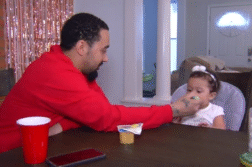DALLAS, Texas. (Ivanhoe Newswire) – By the time they reach 50 years old, 30 to 50 percent of men will experience benign prostatic hyperplasia, or BPH, also known as an enlarged prostate. It can be debilitating and make it almost impossible for these men to urinate. If left untreated, the prostate will continue to grow, along with the problem. Now a new treatment is helping to clear the way and get these men going again, HoLEP.
The pain, discomfort, and helplessness that Jason Horvath was feeling are the same symptoms millions of men experience each year due to an enlarged prostate.
“I couldn’t work. I couldn’t function. I could not empty my bladder. I was in dire straits,” Horvath exclaimed.
Urologist Marawan El Tayeb at Baylor Scott & White Medical Center – Temple stated, “Prostate problems can be pretty serious. It starts with mild symptoms. It can seriously progress into urinal retention and cause an inability to urinate. After that, it can progress to renal failure.”
Dr. El Tayeb sees up to 20 men a day suffering from BPH. The first line of treatment is medication. If that doesn’t work, doctors progress to minimally-invasive treatments, and one of the newest, most effective procedures is the HoLEP—a type of laser surgery used to open any blockages and remove the enlarged prostate tissue.
“If you can imagine, the prostate is like an orange with the peel outside and the fruit inside. Basically, we go around the fruit, taking it out of the peel and leave the patient with a very nice open channel for them to urinate,” Dr. El Tayeb explained.
Seventy percent of patients leave the hospital the same day and 95 percent will have the catheter removed the following day.
“So, the patient will feel the benefit as soon as the catheter comes out. They will start feeling that they are much better. The stream is much better, and they will feel immediate benefit,” Dr. El Tayeb added.
Some possible, but rare side effects include temporary burning or bleeding during urination and urinary incontinence immediately after surgery. An enlarged prostate can be caused by BPH but also can be caused by prostate cancer, which affects one in six men in the United States. That’s why it’s very important to get a PSA test and possible biopsy before treatment.
Contributors to this news report include: Marsha Lewis, Producer.
To receive a free weekly e-mail on medical breakthroughs from Ivanhoe, sign up at: http://www.ivanhoe.com/ftk
Source:
https://www.medscape.com/answers/437359-90389/how-common-is-benign-prostatic-hyperplasia-bph
MEDICAL BREAKTHROUGHS
RESEARCH SUMMARY
TOPIC: HOLEP TREATMENT RELIEVES ENLARGED PROSTATE
REPORT: MB #5035
ENLARGED PROSTATE BACKGROUND: Benign prostatic hyperplasia (BPH), also called prostate gland enlargement, is a common condition as men get older. An enlarged prostate gland can cause uncomfortable urinary symptoms, such as blocking the flow of urine out of the bladder. It can also cause bladder, urinary tract or kidney problems. Although benign prostatic hyperplasia rarely causes symptoms before age 40, the occurrence and symptoms increase with age. Benign prostatic hyperplasia affects about 50 percent of men between the ages of 51 and 60 and up to 90 percent of men older than 80, according to the National Institute of Diabetes and Digestive and Kidney Diseases.
ENLARGED PROSTATE DIAGNOSIS: Some symptoms of an enlarged prostate to look out for include but are not limited to: a weak or slow urinary stream, a feeling of incomplete bladder emptying, difficulty starting urination, frequent urination, getting up frequently at night to urinate, or a urinary stream that starts and stops. If you notice any of these symptoms, it’s important to contact your primary physician as soon as possible. Tests such as urine flow study, digital rectal exam, prostate-specific antigen (PSA) blood test, cystoscopy, ultrasound or prostate MRI may be used to confirm the diagnosis. Treatment for BPH may depend on the severity of the symptoms and range from no treatment to medication or surgery.
(Source: https://www.webmd.com/men/prostate-enlargement-bph/features/enlarged-prostate-bph-complex-problem
NEW TECHNOLOGY: Physicians at UC San Diego Health are now offering prostate artery embolization (PAE) as a new treatment option for men with benign prostatic hyperplasia (BPH), or an enlarged prostate. The minimally invasive procedure is an alternative to surgery, with no hospital stay, little operative pain and lower cost. UC San Diego Health interventional radiologists and urologists screen patients as potential candidates for PAE. Typically, candidates are 50 to 85 years of age, have urinary tract symptoms, have unsuccessfully tried medications within the last six months and have undergone assessment for prostate cancer risk. It is important that patients understand the full range of available treatment options to make an informed decision and pursue the treatment best for their individual medical situation.
FOR MORE INFORMATION ON THIS REPORT, PLEASE CONTACT:
Deke Jones
(214) 820-6722
If this story or any other Ivanhoe story has impacted your life or prompted you or someone you know to seek or change treatments, please let us know by contacting Marjorie Bekaert Thomas at mthomas@ivanhoe.com




